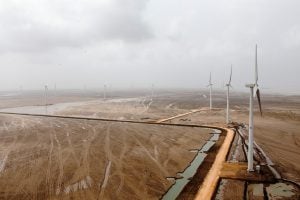Chinese investment has stimulated a wave of new renewable energy generation projects in Brazil. The growth of wind power and nascent solar power, much of which is through small-scale distributed generation, has attracted new players such as Huawei, BYD, Yingli, and Goldwind to the Southern Cone.
In August, Huawei signed its first contract to supply inverters (devices that convert the direct electrical current produced by solar panels to the alternating current used in grids) for a planned solar plant in the state of Minas Gerais, southeast Brazil. In December, BYD will inaugurate its solar plant in the state of São Paulo, also in the southeast, where it already has an assembly line for its electric vehicles.
Many of Brazil’s big energy contractors have been implicated in the far-reaching investigation into corruption at state-run oil company Petrobras and their owners are selling-off assets to cover their debts. The country’s economic problems have also exacerbated the need for foreign investment in energy.
“The winds of political and economic crisis have opened a window of opportunity that the Chinese strategy, patience, was waiting for,” said Eduardo Bernini, of the Getulio Vargas Foundation (FGV-SP), who is also a former president of energy company AES Brasil.
There are other factors too. Slower growth in China has led companies to look to new horizons, and they have identified Brazil’s deficient infrastructure as an area for development. The arrival of big state-owned Chinese players in recent years has opened the door for compatriot suppliers looking to compensate for lower levels of activity at home.
Onshore wind and photovoltaic solar installations alone will represent 75% of new global energy generation in the medium term, according to estimates by the International Energy Agency (IEA). The IEA also indicates that renewable energy will account for 28% of global generation in 2021, compared to 23% last year.
A recent study by the Institute for Energy Economics and Financial Analysis (IEEFA) shows that the BRICS group (Brazil, Russia, India, China, and South Africa) face annual shortfall of US$51 billion in finance for clean energy since they place the required amount across member countries at US$177 billion and they are currently investing only US$126 billion.
In Brazil, for example, new wind farms have already added 10 GW, while solar energy is trying to advance with contracts for a further 2 GW.
However, it appears Chinese investors are not only interested in Brazil’s renewables. Soon after CPFL Energia announced that its controlling shareholder Camargo Corrêa, had closed a deal to sell 23% of its electrical power group to China’s State Grid, the Chinese distribution giant expressed an interest in the shareholdings of some of Brazil’s most significant state companies’ pension funds. Two months later, the acquisition was approved by the National Electric Energy Agency (ANEEL) and the Administrative Council in Defence of Competition (CADE), the national antitrust agency.
One week later, the Banco do Brasil pension fund (Previ) announced it would also sell its share in the company under the same conditions as the first offer. As a result, State Grid, one of the leading companies in the Chinese electric sector, will have between US$ 3.1 billion and US$ 3.7 billion in the bank resulting from these acquisitions.
The purchase is shaping up to be the largest made by a Chinese company in the electricity sector, surpassing the two dams (Ilha Solteira and Jupiá, the largest assets of state-run CESP) acquired by China Three Gorges (CTG) last year. CTG also closed a deal in which it acquired the Brazilian assets of the US’ Duke Energy, elevating the company to one of the largest private energy generators in terns if installed capacity. Hydroelectric power plants are the country’s main source of energy, but Brazil has virtually frozen hydroelectric development for environmental reasons.






